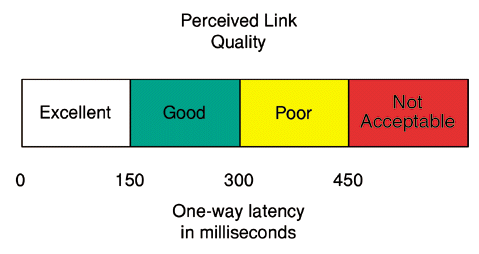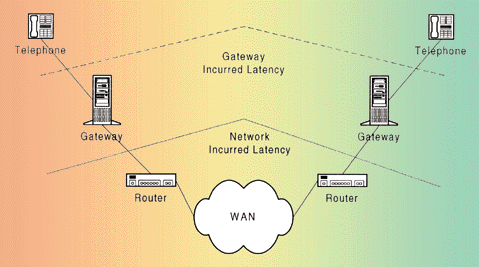
August 1999
Don't Let Latency Hold Up Your Internet Telephony
Network
BY ALAN PERCY
An increased interest in implementing and deploying IP telephony applications has
brought about a rising need to understand the cause and effects of latency in the deployed
system. To get the full picture, we must review the effects of latency on human
conversations, analyze the system components that incur the latency, and study the methods
of managing the latency to maintain sufficient quality of service (QoS)
When building and deploying an IP telephony solution, many different technical
attributes will affect the quality of the final system. These attributes include the
selection of a voice coding (vocoder) algorithm, the system latency, link dependability,
and others. Assuming the IP telephony solution will use an industry standard vocoder,
latency becomes the most important attribute that designers have control over and can have
the greatest effect on QoS.
EFFECTS OF LATENCY
Latency is the time delay incurred in speech by the IP telephony system. It is
typically measured in milliseconds from the moment the speaker utters a word until the
listener actually hears the word. This is termed “mouth-to-ear” latency or the
“one-way” latency that users would realize when using the system. The round-trip
latency is the sum of two one-way latency figures that make up a telephone call. In the
traditional PSTN, the round-trip latency for domestic calls is virtually always under 150
ms. At these levels, the latency is not noticeable to most people. Many international
calls (especially calls carried via satellite) will have round-trip latency figures that
can exceed one second, which can be very annoying for users.
A telephone conversation between two people depends on the timing of the speech more
than most people realize. Most conversations include little utterances by the listener
that serve as acknowledgments back to the speaker, confirming that the listener is
actively engaged in the conversation. Listen to yourself carefully the next time you are
on the phone with someone. Notice the small utterances that you will naturally say even
though the other party is doing most of the talking. If you remove these utterances, the
speaker will stop to wait for your feedback. If you delay the utterances, they will come
to the speaker at the wrong time, resulting in confusion and an interruption of the flow
of conversation. Try delaying or stopping these utterances and notice what happens to your
telephone conversation.
ACCEPTABLE AMOUNT OF LATENCY?
As with most human factor considerations, everyone has his or her own opinion on
this issue, but there is a definite maximum latency that will be tolerated by users. The
exact amount of latency, however, is hard to define because users will balance the
degradation of added latency against the perceived value added by the system. Wireless
telephone services are prime examples of how reduced connection quality will be accepted
when balanced against the added value of high mobility.
Assuming that an IP telephony system is primarily used in a cost-reduction or
“toll bypass” application, the chart in Figure 1 shows
a relationship between user-perceived link quality versus the amount of one-way latency.
Other applications with higher perceived value will surely accommodate greater latency
figures.
Figure 1. Quality
Perception versus Latency

The user perception of the link quality deteriorates as the one-way latency exceeds 150
ms. If the one-way latency exceeds 450 ms, holding a conversation is difficult and the
latency becomes very annoying. If given a choice, most callers would choose to use a
telephone line with less than 200 ms of latency. This gives a target figure for an IP
telephony system — keeping the one-way latency under 200 ms. Even if a caller can get
great sound quality and much lower cost with your solution, that caller will typically go
elsewhere if the latency is excessive.
CAUSES OF LATENCY
Generally, an IP telephony system is constructed using gateways to interface
existing telephone equipment over a wide-area network (WAN). This typical deployment is
shown in Figure 2, which illustrates two endpoint
telephones connected to a WAN via gateways and routers.
Figure 2. Typical IP
Telephony System

Even if a system integrates the gateway functionality into the telephones or the
routing equipment, the same basic processing must take place. Every call using IP
telephony requires two gateways — only the location of the gateways changes.
Latency in an IP telephony system is introduced by two primary sources. Some of the
latency is incurred in the gateways at either end, and the remainder is incurred in the IP
network that connects the two gateways. Since latency is cumulative, any latency
introduced by a component in an IP telephony system will directly affect the total latency
experienced by the user.
MANAGING LATENCY
Managing the latency in a deployed IP telephony system is key to the success of
the resulting service. Some key steps that can be taken to reduce and manage the latency
are:
- Know the sources of latency in your system (do a latency budget). Having a latency
budget helps you set a target and identify areas that can be improved. Without a complete
understanding of the various components that contribute to the total latency, you
won’t have a clear picture of where latency can be trimmed.
- Use routing equipment that supports prioritization of selected ports or provides RSVP to
guarantee a certain level of packet throughput. Carefully selecting and managing your
routing equipment is key to the success of your deployed system.
- Ensure that your network has sufficient bandwidth to avoid congestion. An important tool
in managing bandwidth and congestion is the selection of proper vocoders. Use IP telephony
platforms that allow dynamic switching of vocoders on a call-by-call basis or even within
a call. This will allow the network to respond to available bandwidth conditions in real
time.
- Stay away from equipment and media that you do not have control over (the public
Internet). Having the ability to set priorities, meter link throughput, and adjust
priorities are all required in maintaining a minimum of latency in an IP telephony system.
- If you use a network carrier, ask for a guaranteed route. This will eliminate many
time-of-day variables in the system.
- Reduce packet overhead. If feasible, use piggybacking in your design to send multiple
channels of voice data to the same destination. Efficient use of piggybacking can reduce
total network traffic by over 50 percent, leaving more room for growth.
Building an effective and high-quality IP telephony solution requires that each
component in the system be carefully selected to avoid unnecessary and irritating latency
in voice calls.
Alan Percy is senior sales engineer at Brooktrout Technology. Brooktrout
Technology, a Brooktrout Company, provides enabling technologies for customers to deliver
voice, fax, and data solutions for the electronic communications market. Brooktrout
Technology’s high-performance, high-quality products include: Voice, fax, remote
access and WAN access cards, application development tools, and voice systems. For
additional information, visit the company’s Web site at www.brooktrout.com.
|